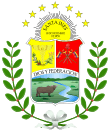Barinas (state)
Barinas State (Spanish: Estado Barinas, IPA: [esˈtaðo βaˈɾinas]) is one of the 23 states (estados) into which Venezuela is divided. The state capital is Barinas.
Barinas | |
|---|---|
 Flag | |
| Motto(s): | |
| Anthem: Himno del Estado Barinas | |
 Location within Venezuela | |
| Country | Venezuela |
| Created | 1937 |
| Capital | Barinas |
| Government | |
| • Body | Legislative Council |
| • Governor | Argenis Chávez (2017–present) |
| • Assembly delegation | 6 |
| Area | |
| • Total | 35,200 km2 (13,600 sq mi) |
| Area rank | 8th |
| 3.84% of Venezuela | |
| Population (2011) | |
| • Total | 816,264 |
| • Rank | 15th |
| 2.87% of Venezuela | |
| Time zone | UTC-04:00 (VET) |
| ISO 3166 code | VE-E |
| Emblematic tree | Cedro (Cedrela odorata) |
| Website | www |
Barinas State covers a total surface area of 35,200 km2 (13,600 sq mi) and, in 2015, had an estimated population of 970,689.
Toponymy
The toponym "Barinas" is a variant of "varinas" (the name of an indigenous ethnic group that inhabited the Piedemonte for the arrival of the Spaniards); this may have a relationship with the name "Barima", given by the tunebos to the Santo Domingo river in the Aya myth. The meaning is unknown, but, according to popular belief, it is 'strong wind that comes from the valleys of the Santo Domingo river', referring to the Barinese wind, which blows in the Llanos Altos.

According to Virgilio Tosta the first use of the place name was before 1628, as an alternative name for Altamira; in contrast, according to Betancourt Martínez, it was in the foundations of Barinitas such as Nueva Trujillo de Barinas (1628) and Barinas (1759). It expanded with the creation of the Province of Barinas in 1786, and in 1859 it was reduced to the present region.
Senna aculeata - a low, thorny, yellow-flowered shrub that abounds in the state - is sometimes called the barinas flower because of this toponym, which is why it is the state flower.
History
Georg von Speyer and Nikolaus Federmann explored the region in the year 1534 on their way to the Andes.
In 1542, Philipp von Hutten traveled from Coro over this area en route towards Colombia. In 1547, Alonso Pérez de Tolosa, who came from El Tocuyo, crossed the territory of Barinas.
Pre-Columbian era
The pre-Columbian history of the Western Plains develops mainly around the present day territory of Barinas, which was a highly mobile area where numerous indigenous ethnic groups from the Orinoco, the Amazon and the Andes interacted, using the abundant rivers and the highlands as convenient communication routes.
Starting in the 11th century. C. and ending with the colonization, it is considered that there were several successive occupations, which left as evidence, in addition to at least thirty-three petroglyphs and many lithic types in the Piedemonte, more than a score of mounds and roads - long camels - that extend throughout the plain from Colombia, and that could be used for economic, military and/or religious purposes.
The indigenous presence begins with the inhabitants of the Agua Blanca complex, about which there is not much information.
Since 250 A.D., groups from the Oriente of Colombia and Ecuador have settled in the Llano Medio of Bariné, since this area is characterized by good soils and little flooding. This occupation is characterized by the oldest roads and mounds found in the region today, and by the ceramic complex of the El Oso stream. Their settlements were sedentary and subsisted through the cultivation of corn, hunting and fishing. El Piedemonte was an area of exchange with Andean groups during this period.
From 650 to 1200, Araucanian groups dominated the region, inhabiting its wooded areas and bringing with them the chiefdoms and, therefore, the war relations. The period was also characterized by a remarkable population growth and an extension of the groups to the vicinity of the current Guanarito. A possible influence of the groups from the Central-West of Venezuela can also be seen in the use of ceramics.
During different periods, the Arawak moved around the region, from which they left for Zulia and the Central-Western part of Venezuela, introducing the cultivation of yucca and establishing trade routes throughout the Orinoco basin.
The Tunebos explored and occupied the Piedemonte and the Llanos Altos of the state, starting from the Sierra Nevada of El Cocuy and the savannas of Casanare, following their tradition of occupying three altitudinal levels and bringing a large part of the Chibcha element to the region.
Spanish Colonial Period
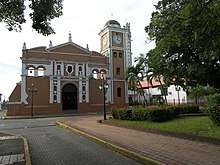
For the arrival of the Spaniards the territory of the state was populated by numerous tribes, already organized in communal agricultural societies, among which the apures, aitures, amaibas, achaguas, baraures, barrancas stand out, the canaguaes, the capas, the cúcuaros, the curaguas, the caquetíos, the curayes, the dásaros, the duriguas, the guahibos, the güeros, the orúes, the ticoporos, the michayes, the suripaes, the torunos, the tobores, the tucuriguas, the puyures and the varinas .All these tribes were extinct or disappeared from the state due to colonization, but in many cases their names remained as place names throughout the state - as is the case of Torunos and Barrancas.
In 1535, the first presence of Europeans in the region took place, this time on behalf of the Welsares, when the then governor, Jorge de Espira, crossed Barinas along with his group during his expedition in search for El Dorado del Meta and faced jirajaras along the way. Nicolás Federmán passed by the present Arismendi the same year. Philip of Utre, who had accompanied Espira, repeated his expedition in 1541. Alonso Pérez de Tolosa also crossed Barinas in 1549, heading for El Tocuyo, after having failed in a conquest entrusted to him by the then governor Juan Pérez de Tolosa.
Altamira de Cáceres
The colonization of Barinas began on June 30, 1577, when Captain Juan Andrés Varela, commissioned by the governor of the Province of La Grita, Francisco de Cáceres, choosing a mountainous place but close to the Llanos, founded, along with meridians and on the valley of the Santo Domingo River, the city of Altamira de Cáceres.
The primitive Altamira was a little inhabited city, firstly because its inhabitants led a dangerous life being close to the jirajaras, and because they had little space to build. The precariousness of the conditions of the city was such that Varela decided to resign his post as mayor a few months after founding it and, a decade having passed since the foundation, its inhabitants showed a desire to move.
In spite of the inconveniences, Altamira was populated for four decades thanks to cattle raising and, even more so, tobacco cultivation, and was able to compete with Cuba in the beginning. Even so, the population of the city did not prosper as expected, reaching only sixteen Creoles and two hundred and fifty Indians; this in spite of the fact that, according to Virgilio Tosta, "tobacco turned the primitive Barinas into a globally famous name".
New Trujillo of Barinas
The citizens of Altamira gradually moved towards El Llano, until in 1628, by order of the governor of the Province of Mérida and La Grita, Juan Pacheco Maldonado, the re-founding of the city was approved on the Moromoy table, with the name of "Nueva Trujillo de Barinas" - today Barinitas. This event was due to the fact that this plateau is closer to the Llanos to be conquered, while having much better land for livestock and tobacco cultivation (which had become intensive due to the high demand and had generated a great deal of smuggling led by the Dutch).

Nueva Trujillo is considered the "gateway to the conquest of the Llanos", because from here important settlements were founded in view of the Llanos: the town of doctrine of Nuestra Señora de la Concepción del Curay (1619, today's La Barinesa), the city of Nuestra Señora de Pedraza (1951, today's Ciudad Bolivia), and the Indian towns of Santa Bárbara and Curbatí.
After the sacking of Maracaibo and the burning of Gibraltar by the Dutch (1641), the Barinese thought of alternate trade routes; thus, in 1647, Miguel de Ochogavia undertook the successful expedition to discover the Santo Domingo-Apure-Orinoco connection, through which the subsequent conquest of Apure was carried out. This discovery led to the subsequent emergence of the ports of Torunos and Nutrias.
Spanish Province of Barinas
After the foundation of Nueva Trujillo, and because of the progressive pacification of the Indians, the development of extensive cattle raising, the general interest in evading the taxes of the Crown and the fall in demand for tobacco by the end of the 17th century, the Barinese abandoned the table of Moromoy to populate the savannas around the rivers Santo Domingo, Masparro and Boconó, establishing their herds there and arriving to form important towns, such as Sabaneta, Barrancas and Obispos. For this reason, on July 11, 1759, the Viceroy of the New Granada, Jose Solis, decreed the definitive foundation of Barinas, with the name and on the current place - where the town of San Antonio de los Cerritos was by then -, in order to establish a center of power closer to the new towns.
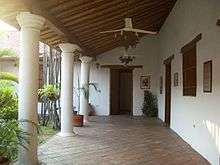
Barinas was part of the Captaincy General of Venezuela since its creation. On February 15, 1786, King Carlos III decreed, over a territory that extended to cover the current states of Apure and Portuguesa, the creation of the Province of Barinas, separating it from that of Maracaibo. During this period there was a remarkable diversification and economic growth, being stimulated the trade and cultivation of tobacco, sugar, indigo, cocoa, cotton, onoto and coffee. Also the Spaniards built the first prison and the first hospital. There was also a great population growth, as the censuses of the time show.
Barinas defeated the Comuneros of the Andes (1781), a fact that led to King Carlos IV granting it in 1790 the coat of arms that today retains the state capital, along with the motto "very noble and very loyal".
Independence Process
Barinas joined the process of the Supreme Board of Caracas on May 5, 1810, thus constituting a Board of Government and Conservation, in which the desire to break with the Crown was formed. He signed the Declaration of Independence Act (1811), thus forming part of the First Republic, which fell the following year.
After the patriotic victory in the Battle of Niquitao, on July 2, 1813, Barinas became part of the Second Republic, which also fell the following year. Paez's campaigns ensured the patriotic victory in Barinas during the Third Republic, in which Venezuela's independence was consolidated.
Young Barineses like José Antonio Páez and Pedro Briceño Méndez were important heroes of the Independence.
Contemporary period
The Province of Barinas during the contemporary period
During the existence of Greater Colombia there were several general political-administrative changes. In 1821, the Congress of Cúcuta created the Department of Venezuela, including Barinas. Two years later, the Congress of the Republic separated the current territory of the State of Apure from Barinas, making it a province, with the capital in Achaguas.
In 1824, in view of the Territorial Division Law, the Department of Venezuela disappears and the Department of Apure is created, consisting of the provinces of Barinas and Apure. Two years later, these provinces became part of the Department of Orinoco, along with Guayana.
After the dissolution of the Great Colombia, the cantons of Guanare, Ospino and Araure initiated managements to segregate themselves from the Province of Barinas, fact that would occur in 1851, when the National Congress erected the Province of Portuguesa.
Barinas State
During the Federal War (1859-1863), General Ezequiel Zamora maintained federalist control of all the Western Plains from Barinas, and consolidated it with the Battle of Santa Inés, on December 10, 1859; after this victory, Zamora left the proclaimed State to besiege San Carlos, being killed there. In honor of these facts, Barinas was renamed "Zamora" in 1862, recovering its original name in 1936. As all other Venezuelan provinces, Barinas became a de jure state since the proclamation of the United States of Venezuela, with the Constitution of 1864, thus repealing the ephemeral merger it had with Apure during the last year of the War.
On April 30, 1879, in accordance with the Guzmancism's plan for the reduction of states, it was proposed the conformation of the South State of the West from the territories of the states of Barinas, Carabobo, Portuguesa and Cojedes and the Department of Nirgua of the State of Yaracuy, denominated as "sections"; however, after the protest of Barinitas for the distance of Valencia as capital, such union was given excluding Carabobo and Nirgua. Barinas proposed to include Apure as part of the State.
Despite the fact that the South West later acquired the name "Zamora", the centre of power was not in Barinas, but in Ospino, provisionally, and then in Guanare. At the end of the 1880s and in view of the secessionist movement of Cojedes, the idea of the disintegration of the South West in Barinas was promoted. It is on April 22, 1899 when, by unconstitutional decree, the government of Ignacio Andrade separates the sections of Zamora, without giving them back their previous degree of autonomy
In 1989 the states were granted greater political autonomy with the country's first regional elections.

Geography
Relief and geology
The Western Plains predominate. These extend from the Camaguán marshes in the far east and rise in height towards the west, thus dividing into the Lower Plains, up to 120 m above sea level, the Middle Plains, up to 160 m above sea level, and the Upper Plains, up to 200 m above sea level.
This plain ends abruptly where Troncal 5 passes, that is, in a line that goes from the town of Las Veguitas to Punta de Piedras, from which the Mérida mountain range begins, the final part of the Andina. The lowest and least rugged part of this part of the mountain range is the Sierra del Piedemonte, in which hills, small mountains, depressions and mesas predominate. The highest and most rugged part is the Sierra Nevada, the Sierra del Tapo-Caparo and the Sierra de Calderas, with the first peak close to 4 000 m above sea level inside Barinas, and the last one with a lot of valleys. The tables of Moromoy, El Curay and Parangula are landmarks that separate the high and low parts. Two large passes are found, both to the north: the pass of the valleys and the depression of the Santo Domingo River and the pass of the Boconó River valleys.
In the Paleozoic, the Merida mountain range was formed as an island. The sediments of this mountain range accumulated to the east and west, giving way to the formation of the Llanos, around the Mesozoic.
The most important geological formations in the state are Palmarito, Caparo, with fossiliferous shales, and Sabaneta, with sandstone.
Hydrography
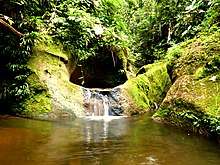
Barinas is characterized by an abundance of rivers, so many that its capital is considered "the capital of the rivers of Venezuela". All its rivers originate in the East of the Mérida mountain range and flow into the left bank of the Apure River, having, for the most part, short upper and middle courses and flooding the Llanos Bajos during rainy periods. The tributaries of the Apure River in Barinas are the Portuguesa, Masparro, Santo Domingo, Caparo, Canaguá and Uribante Rivers, all of which are navigable. Some rivers that flow through the Piedemonte give rise to depressions around it. There are also three reservoirs in the state: those of the rivers Boconó, Masparro and Caparo.
Climate
Being in the intertropical zone and extending more towards the meridians than towards the parallels, Barinas has a climate determined by altitude, winds and two seasons: the dry season, from October to March, and the rainy season, from April to September. Of these factors, the altitude is the one that modifies the temperatures more forcefully. The cold winds that flow from the east of the Mérida mountain range to the Llanos Altos cause the characteristic phenomenon of the Barinese wind. According to Köppen's classification, the Sierra del Tapo-Caparo and the Llanos have a savanna climate (Aw), the Piedemonte and Alto Apure, a monsoon climate (Am), the Sierra Nevada and Sierra de Calderas, a humid mountain climate (Cfbi), and the highest parts of these last two mountain ranges, a tropical alpine climate (ETH)
Flora and fauna
Barinas has two ecoregions: the Llanos and the Northern Andes, the latter being its center of endemism.
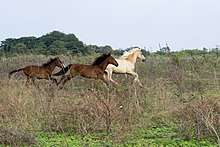
The Llanos constitute extensive grasslands and abundant gallery forests. In its flora there are many trees, among them the apamate, the jabillo, the samán, the ceibas, the mangos, the merecure, the cañafístola llanera and the araguaney, the national tree; there are also many palms, especially the llanera. Among the herbs, the water lilies and the mother-of-pearl and barina flowers stand out.
The Mérida mountain range, on the other hand, has, from its highlands to its foothills, moors, tropical mountain forests and wooded savannas. Among its vegetation, the cardón, cují, bucare and frailejones are characteristic in its upper parts, while in the foothills pardillo, granadilla, caobas and vera abound.
There are more than 450 species of birds, among which are the prey species - especially the Andean condor -, herons, storks, ducks, the parachute, the Orinoco woodpecker and the carrao.

Mammals are the most abundant vertebrates, highlighting the deer, foxes, otters, anteaters and honey bears, the cachicamo, the cunaguar, the jaguar, the spider monkey and the capuchin, the rabbit and, above all, the chigüire. Rabbits, spectacled bears, porcupines and shrews are found only in the Andes.
In the Llanos, there is an abundance of reptiles, including anacondas, podocnemids, iguanas, rattlesnakes, babo, jicotea turtles, mato real, Orinoco caiman and mapanare.
Fish populate all the rivers, with catfish, piranhas, goldfish and electric eels being abundant in the Llanos, and trout in the Andes.
There are also two species in danger of extinction: the morrocoy sabanero and the tonina.
Territorial Division
Barinas, like all the states in the country, is divided into municipalities, which in turn are subdivided into parishes. The 12 municipalities of Barinas are organized according to population conditions - which must be greater than ten thousand for each one - economic development, capacity to generate their own income, geographical situation, historical and cultural elements and other factors that are considered relevant. They constitute historical institutions of natural law and are considered to be the most cohesive entities after the family.
The parishes of Barinas are considered to be the best places to achieve greater efficiency in the management of local governments, citizen participation and decentralization
Municipalities and municipal seats
- Alberto Arvelo Torrealba (Sabaneta)
- Andrés Eloy Blanco (El Cantón)
- Antonio José de Sucre (Socopó)
- Arismendi (Arismendi)
- Barinas (Barinas)
- Bolívar (Barinitas)
- Cruz Paredes (Barrancas)
- Ezequiel Zamora (Santa Bárbara)
- Obispos (Obispos)
- Pedraza (Ciudad Bolivia)
- Rojas (Libertad)
- Sosa (Ciudad de Nutrias)
Economy

The mining potential is expressed by non-metallic minerals such as: limestone, sand, silicate, quartz, red clay, feldspar, gravel, silica sand and phosphorite. As for energy resources, there are hydrocarbon reserves in the southern zone of San Silvestre, where PDVSA exploits several oil fields. In 2001, Repsol YPF was awarded the Barrancas block for the production of 2 million cubic meters of free gas per day. The gas is fed to the Termobarrancas electric plant, in the Obispos municipality, with a generation capacity of 450 megawatts.
Agricultural production in Barinas is very important for the local economy as well as livestock production. The fertile soils of Barinas provide the necessary conditions for the production of corn, sorghum, banana, cocoa, coffee, cotton, sesame. These items are the main axis of agriculture in Barinas State.
Tourism
Barinas has a contrast between landscapes of mountains, plains, rivers and streams, offering the tourist a variety of options, from contemplating rare species in their habitat, to enjoying its spectacular parks and natural spas.
From the city of Barinas to the state of Merida, passing through the municipality of Bolivar, which includes the towns of Barinitas, Altamira de Caceres and Calderas, with a pleasant climate, characteristic of the tropical rainforest.
Barinitas, capital of the municipality has the Moromoy Park where you can camp, the Balneario La Barinesa with recreational facilities and towards the southeast the El Cacao Sector, where you can practice mountain biking. There is also the boulevard of Plaza Bolívar and the San Pedro Church. The route that leads to Altamira de Cáceres, is used for bird watching because of the diversity of species, especially the Cock of the Rock.
Altamira de Cáceres is the first seat (1577) of what today is the city of Barinas. It still preserves its colonial architecture, with its historic red-roofed houses.
The Plaza Bolívar was converted into a boulevard and in its surroundings you can find the Church, the Alfredo Arvelo Larriva House of Culture, inns, restaurants, wine cellars, bakeries, shops selling local sweets and handicrafts.
At a distance of 20 minutes following this mountain route towards the town of Calderas (founded in 1628), you will find the "Los Castillos" mill, near the "La Bellaca" farmhouse, where the artisan process of making panela is carried out, produced by the locals since past times.
When you arrive at Calderas, you can visit natural places with recreational facilities, such as the "La Piedra del Patio" spa, on the banks of the Azul River or Calderas. You can visit the house of the Avelino Moreno culture and the "Centro de Enseñanza para el Desarrollo Rural" (CENDER).
The route that leaves from the city of Barinas towards the Portuguese State, highlighting in this journey two important reservoirs, as the Manuel Palacio Fajardo (Masparro) located 15 minutes from the town of Barrancas and Juan Antonio Rodriguez Dominguez (Boconó - Tucupido) located on the border with the Portuguese State, where you can make boat trips, kayaking and jet skiing, bird watching, and controlled sport fishing. The population of "Obispos" (founded in 1713) is dominated by the cultivation of mussels, corn, cotton, sorghum, and forest products, in addition to livestock and oil exploitation.
Its colonial temple of San Nicolás de Bari was built in the 18th century) and there are also popular expressions such as the joropo, corrío, coplas, tonadas, bullfighting and patron saint festivities.
Along the road that leads to Trunk 5, from Puente Paez, via Sabaneta, are the towns of Mijagual, Santa Rosa, Libertad, Dolores, City of Otters and finally Puerto de Nutrias, bordering the State of Apure. You can see large scale plantations of oilseeds, cereals, sugar cane, tomatoes, yucca and fruit trees, as well as a livestock area.
In Sabaneta, the cultural aspect of Los Diablos Danzantes de San Hipólito stands out, and in the musical aspect, there are the celebrations of the Festival de la Bandola in the town of Dolores (December), the Festival de la Libertad and La Paz (January) and the making of typical musical instruments in the town of Libertad.

At 35 kilometers from Barinas via Torunos you can reach the town of El Real. In the month of January and at various times of the year the inhabitants of this area and pilgrims from various parts of the world venerate the image of Nuestra Señora del Rosario del Real, which appeared in the mid-seventeenth century.
When passing the bridge over the River Paguey, we find the village of San Silvestre, which in December celebrates its patron saint's festival in honour of San Silvestre, where the bullfighting is one of the most popular tourist events in the village.
Another site of interest is the Sierra Nevada National Park located between the state of Merida and Barinas. It is a protected ecosystem that has forests, moors, xerophilous scrubs and the highest altitudes in the country, like Pico Bolivar with 5,007 meters above sea level, the Humboldt Peak 4,920 meters above sea level and Bompland 4,942 meters above sea level, La Concha 4,920 meters above sea level, El Toro 4,755 meters above sea level and El Leon 4,740 meters above sea level.
The Balneario Municipal and El Balneario Río Boconó located on the banks of the Cipe River, in the Obispos municipality and in the Alberto Arvelo Torrealba municipality, respectively, are natural spas surrounded by lush trees.
Around Peña Viva there is a vast network of pre-Columbian petroglyphs that constitute the richest and most complete sample known in Venezuela today.
Barinas has a botanical garden located within the Universidad Nacional Experimental de Los Llanos Ezequiel Zamora.

Natural Heritage
- Balneario Municipal
- Balneario Río Boconó
- Canagua
- Bruzual Bridge
- Cerro el Gobernador
- Cave los Diablos
- Cave los Corredores
- Unellez Botanical Garden
- La Acequia
- La Piedra del Patio
- La Yuca Parque
- La Carolina
- Los Samanes Park
- Moromoy Park
- Sierra Nevada National Park
- Tapo-Caparo National Park
- Sabana de Anaro
- Masparro River
- Pagüey River
- Santo Domingo River
- La Yuca River

Outstanding buildings
- House of Culture
- House of the Poet Lazo Martí
- Alfredo Arvelo Larriva Cultural Center
- Virgen del Real Tourist Complex
- El Calvario Manuel Reservoir
- Church of St. Nicholas of Bari of Obispos
- Church of the Immaculate Conception
- Alberto Arvelo Torrealba Museum
- El Marqués Palace
- Rafael Calvo Municipal Art Workshop
Demography
In the State of Barinas, the rural population had traditionally predominated, and it was estimated that in 1950 the rural population corresponded to 84.8% of the total population of Barinas. The population of Barinas State, in the 1990 Census was 424,491 inhabitants. The population estimate for 2015 is 901,129 inhabitants.
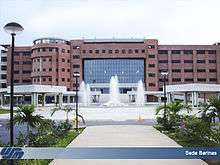
| Year | inhabitants |
|---|---|
| 1873 | 49.448 |
| 1881 | 56.765 |
| 1891 | 62.696 |
| 1920 | 55.055 |
| 1950 | 85.944 |
| 1961 | 169.271 |
| 1971 | 231.046 |
| 1981 | 326.166 |
| 1990 | 424.491 |
| 2001 | 624.508 |
| 2011 | 854.391 |
| 2015 | 980.490 |
The State in general has the second largest Colombian community in Venezuela with more than 300,000 after the State of Táchira. These are grouped in the different and main cities of the entity being the city of Barinas the one with more presence. This immigration, which has been in this region for more than 40 years, is mainly due to the internal problems of the neighboring country, such as violence and economic problems.
Sports
The state of Barinas has a First Division football club, called Zamora Fútbol Club, founded on February 2, 1977, and the stadium in which they reside is La Carolina Stadium, also one of the stadiums used for the 2007 Copa America, held in Venezuela.
Likewise, in 2007, Barinas hosted the second leg of the Nissan South American Cup between Zamora FC and Olmedo of Ecuador, which the visiting team won 2 goals to 1, being this the first international match of Zamora FC. Subsequently, it hosted three South American Cup matches and three editions of the Copa Libertadores.
In 2011, Zamora Fútbol Club won the Clausura Championship and was runner-up in Venezuela. And by the middle of the year 2013, they will rise with the Clausura Championship for the second time, and will be the champion of the Venezuelan Professional Football Tournament against Deportivo Anzoategui. In 2013, Zamora Football Club won its first absolute championship, by being proclaimed champions of the 2013 Closing Tournament, in May 2014 it won its Absolute Bicampionship vs Mineros de Guayana, and in December 2016 it got its third star (absolute championship) in 5 years after being crowned champion in the Opening Tournament vs Deportivo Anzoátegui and winning the Absolute Final vs Zulia FC.
The Varyna Sport Volleyball Club of the national professional volleyball league in Venezuela was also created in 2011.
In Baseball, the Petroleros de Barinas Team was established, which plays the Venezuelan national parallel league, where it has been proclaimed champion twice.
Transport
The state's road network is the main means of communication both internally and with the rest of the country. This road has 7,094.5 kilometers of trunk roads of which only 15% are paved, so it is advisable to travel in all-terrain vehicles. Trunk 5 is the most important road axis and communicates Barinas with the states of Portuguesa and Táchira and Apure.
Government & Politics
Barinas is a state that is part of the Venezuelan federation, which is symmetrical: each entity has its own legal personality, competences and income, and has autonomous executive and legislative power, with authorities elected by majority rule in universal, direct and secret suffrage for four-year periods and revocable by referendum. They also have their own autonomous comptroller's and procurator's office and a council for planning and coordinating public policies. Venezuela's states are obliged to maintain independence, sovereignty and territorial integrity, and to comply with and enforce the Constitution and the law.
The Barinas law emphasizes decentralization as the main goal.
The foundations of the essence of Barinas are in the ethical and moral heritage of its people, in the values of freedom, equality, justice, cooperation, solidarity and independence, in the personal values and spiritual potential of its people, in its natural resources and in its history, its traditions, its customs, its idiosyncrasy, its folklore, its art and its own aspirations. Barinas must also protect, together with its neighbouring states and with all the means at its disposal, biodiversity, which includes cultural diversity.
The aims of the Barinese State are: to protect and defend the person and his dignity, to facilitate the exercise of the popular will and citizen participation in public affairs, to maintain freedom, to promote private initiative and free enterprise and the welfare of the people. Education and work must be the means to achieve these ends.
The citizens of Barinas are obliged by law to protect the family, know, promote and protect the cultural heritage, contribute to economic and human development, encourage private initiative and the promotion of free enterprise and reject violence. They also have the right to participate freely in state public affairs, in the exercise of control, monitoring and supervision of public management and in the processes of decentralization
Executive
The executive power of each state in Venezuela is exercised by the governors, who in the case of Barinas could be reelected only once, until the national constitution is reformed in 2009. The governor of Barinas is elected by direct universal and secret ballot every 4 years and has, as assistants, his secretaries. The objectives of the government of Barinas according to the law are: to achieve the spiritual, educational and economic elevation of the people, to create a framework of incentives that allow the achievement of technological innovations that contribute to the integral development of the State and to create the conditions that raise the levels of productivity in the economic activities.
Governors
Zenaida Gallardo was sworn in as the governor of Barinas State on 5 January 2017, replacing Adán Chávez, who was appointed as Venezuelan Minister for Culture on 4 January 2017.[2] Gallardo resigned after only a few months, citing health reasons.[3] In June 2017, Argenis Chávez, brother of former president Hugo Chávez, was sworn in as governor. [3]
Like the other 23 federal entities of Venezuela, the State maintains its own police force, which is supported and complemented by the National Police and the Venezuelan National Guard.
Legislative
The legislative power of each state in Venezuela is exercised by a legislative council, made up of seven to fifteen legislators each, who proportionally represent the population of their states and their municipalities. State legislators may be reelected only twice. The seat of the Legislative Council of Barinas is the Manuel Palacio Fajardo building; its powers are limited to those designated by the constitutions and laws.
See also
References
- "Resultado Básico del XIV Censo Nacional de Población y Vivienda 2011 (Mayo 2014)" (PDF). Ine.gov.ve. p. 29. Retrieved 8 September 2015.
- Globovision. "Zenaida Gallardo estará al frente de la Gobernación de Barinas". Globovisión (in Spanish). Retrieved 2017-05-18.
- "Hugo Chávez's brother becomes governor of Barinas state". BBC News. 7 June 2017.
| Wikimedia Commons has media related to Barinas (state). |
